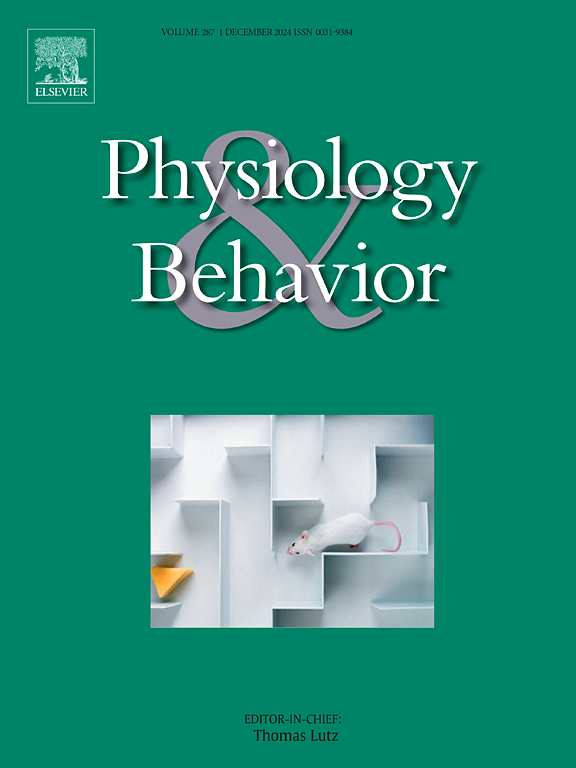Comparison of the estrogen withdrawal and chronic restraint stress and the maternal separation in mice postpartum depression modeling
IF 2.5
3区 医学
Q2 BEHAVIORAL SCIENCES
引用次数: 0
Abstract
Background
Postpartum depression (PPD) is a severe psychological and psychiatric disorder that affects women during the perinatal period. Animal models play a crucial role in studying the pathogenesis of PPD. However, a comprehensive comparison of the distinctive features of estrogen withdrawal (EW), chronic restraint stress (CRS), and maternal separation (MS) rodent models, which are commonly used in PPD research, is lacking.
Methods
Three models of PPD were developed in this study, and the success of modeling was judged by the sucrose preference test (SPT) and the tail suspension test (TST). SPT, open field test (OFT), elevated plus maze (EPM), forced swim test (FST), and TST were performed sequentially at the end of the molding process. Reproductive hormone changes in the peripheral blood, changes in GPR30 expression and GPR30+ astrocytes in the hippocampus were also assessed.
Results
Data from the EW and CRS experiments showed a significant reduction in SPT and prolonging in the immobility time of the TST in subjects after modeling compared to baseline values. In all three models, levels of estradiol showed a significant decrease, whereas levels of progesterone statistically decreased and prolactin significantly increased only in the CRS and MS mice. Western-blot results showed a significant decrease in GPR30 expression in hippocampal regions of EW and CRS mice, while MS mice did not show differences. The EW and CRS models expressed less GPR30+ astrocytes and the morphological complexity of astrocytes was significantly reduced in the hippocampal CA1 region.
Conclusion
The CRS model showed more obvious parameter changes and was closer to clinical PPD, which may be more appropriate to study PPD.
雌激素戒断、慢性抑制应激及母亲分离对小鼠产后抑郁模型的影响。
背景:产后抑郁症(PPD)是一种严重的心理和精神障碍,影响妇女在围产期。动物模型在研究PPD的发病机制中起着至关重要的作用。然而,缺乏对PPD研究中常用的雌激素戒断(EW)、慢性约束应激(CRS)和母分离(MS)啮齿动物模型的特点进行全面比较。方法:本研究建立3个PPD模型,通过蔗糖偏好试验(SPT)和悬尾试验(TST)判断模型是否成功。成型结束后依次进行SPT、open field test (OFT)、elevated plus maze (EPM)、forced swim test (FST)和TST。外周血中生殖激素的变化、GPR30表达的变化以及海马中GPR30+星形胶质细胞的变化也被评估。结果:EW和CRS实验数据显示,与基线值相比,建模后受试者的SPT显著降低,TST静止时间延长。在所有三种模型中,雌二醇水平均显著下降,而孕酮水平仅在CRS和MS小鼠中有统计学意义上下降,催乳素水平显著升高。Western-blot结果显示,EW和CRS小鼠海马区GPR30表达显著降低,而MS小鼠无差异。EW和CRS模型海马CA1区GPR30+星形胶质细胞表达减少,星形胶质细胞形态复杂性明显降低。结论:CRS模型参数变化更明显,更接近临床PPD,可能更适合PPD的研究。
本文章由计算机程序翻译,如有差异,请以英文原文为准。
求助全文
约1分钟内获得全文
求助全文
来源期刊

Physiology & Behavior
医学-行为科学
CiteScore
5.70
自引率
3.40%
发文量
274
审稿时长
47 days
期刊介绍:
Physiology & Behavior is aimed at the causal physiological mechanisms of behavior and its modulation by environmental factors. The journal invites original reports in the broad area of behavioral and cognitive neuroscience, in which at least one variable is physiological and the primary emphasis and theoretical context are behavioral. The range of subjects includes behavioral neuroendocrinology, psychoneuroimmunology, learning and memory, ingestion, social behavior, and studies related to the mechanisms of psychopathology. Contemporary reviews and theoretical articles are welcomed and the Editors invite such proposals from interested authors.
 求助内容:
求助内容: 应助结果提醒方式:
应助结果提醒方式:


